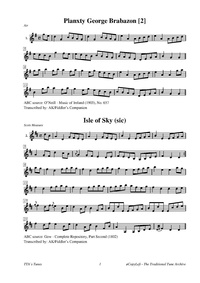Template:Pagina principale/Vetrina: Difference between revisions
No edit summary |
No edit summary |
||
| Line 1: | Line 1: | ||
{{SheetMusic | {{SheetMusic | ||
|f_track= | |f_track=Planxty George Brabazon.mp3 | ||
|f_pdf= | |f_pdf=Planxty George Brabazon.pdf | ||
|f_artwork= | |f_artwork=Carolan-harp-painting.jpg | ||
|f_tune_name= | |f_tune_name=George Brabazon | ||
|f_track_title= | |f_track_title=George_Brabazon_(2) | ||
|f_section= | |f_section=abc | ||
|f_played_by=[https://soundcloud.com/ | |f_played_by=[https://soundcloud.com/gemkos Gemkos] | ||
|f_notes= | |f_notes= Turlough O'Carolan playing in an Irish "Big House". | ||
|f_caption= | |f_caption=was the first O’Carolan work the seminal Irish band The Chieftains recorded, taken by leader and uilleann piper Paddy Moloney from the O’Sullivan collection his sister had given him in 1959 for his 21st birthday. | ||
|f_source=[https://soundcloud.com/ | |f_source=[https://soundcloud.com/gemkos/planxty-george-brabazon Soundcloud] | ||
|f_pix=420 | |f_pix=420 | ||
|f_picpix=200 | |f_picpix=200 | ||
|f_article=[[ | |f_article=[[George_Brabazon_(2) | '''George Brabazon''']] | ||
The | (Pleraca Seoirse Brabason) - The composition has been credited to Irish harper Turlough O'Carolan (1670-1738), for George Brabazon, a young bachelor. | ||
Donal O’Sullivan (1958) included this piece in his definitive work on Carolan, but noted there was no definitive evidence for its being composed by the harper. | |||
Some have attributed Captain Francis O’Neill’s over-zealotous assertion of tunes to O’Carolan as the source for naming him as composer, although stylistically it would seem to be a composition of his. After the Jacobite rebellion “George Brabazon” was re-titled in Scotland "Prince Charlie's Welcome to the Island of Skye" in honor of the Pretender; the first two parts of O'Neill's "George Brabazon" are the first two parts of Glasgow musician James Aird's four-part "Prince Charlie's Welcome" (printed in Selection of Scotch, Irish, English and Foreign Airs, vol. 3). | |||
It also appears in the Gow’s Complete Repository, Part Second (1802) under the title “Isle of Sky” (sic), set as a Scots Measure and with some melodic differences in the second part. This is significant, for it predates the earliest Irish source (O’Neill) by a century (Irish piper O'Farrell's early 19th century London-published version of the tune, "Isle of Sky" was taken from Scottish sources, and provenance is indicated). | |||
The Gows printed several O’Carolan airs, often with different titles. | |||
}} | }} | ||
Revision as of 08:28, 22 July 2023

Played by: Gemkos
Source: Soundcloud
Image: Turlough O'Carolan playing in an Irish "Big House".

(Pleraca Seoirse Brabason) - The composition has been credited to Irish harper Turlough O'Carolan (1670-1738), for George Brabazon, a young bachelor.
Donal O’Sullivan (1958) included this piece in his definitive work on Carolan, but noted there was no definitive evidence for its being composed by the harper.
Some have attributed Captain Francis O’Neill’s over-zealotous assertion of tunes to O’Carolan as the source for naming him as composer, although stylistically it would seem to be a composition of his. After the Jacobite rebellion “George Brabazon” was re-titled in Scotland "Prince Charlie's Welcome to the Island of Skye" in honor of the Pretender; the first two parts of O'Neill's "George Brabazon" are the first two parts of Glasgow musician James Aird's four-part "Prince Charlie's Welcome" (printed in Selection of Scotch, Irish, English and Foreign Airs, vol. 3).
It also appears in the Gow’s Complete Repository, Part Second (1802) under the title “Isle of Sky” (sic), set as a Scots Measure and with some melodic differences in the second part. This is significant, for it predates the earliest Irish source (O’Neill) by a century (Irish piper O'Farrell's early 19th century London-published version of the tune, "Isle of Sky" was taken from Scottish sources, and provenance is indicated).
The Gows printed several O’Carolan airs, often with different titles.
...more at: George Brabazon - full Score(s) and Annotations
X:1 T:Planxty George Brabazon [2] M:C L:1/8 R:Air Q:”Moderate” S:O’Neill - Music of Ireland (1903), No. 657 Z:AK/Fiddler's Companion K:G V:1 clef=treble name="1." [V:1] ge|d2G2 cBAG|d2G2 cBAG|e2A2 ABcd|e2A2 ABcd| edcB g2 fe|edcB cBAG|BAGE DEGA|B2G2G2|| ga|b2 gb a2 fa|g2 eg edcB|e2A2 ABcd|e2A2A2 ga| B2 gb a2 fa|g2 eg edcB|cBAG DEGA|B2G2G2||
